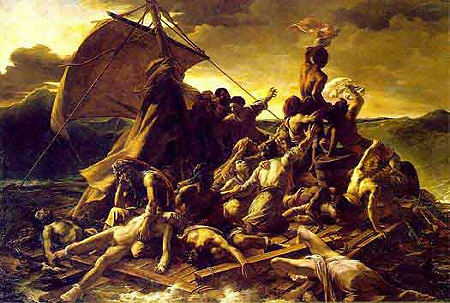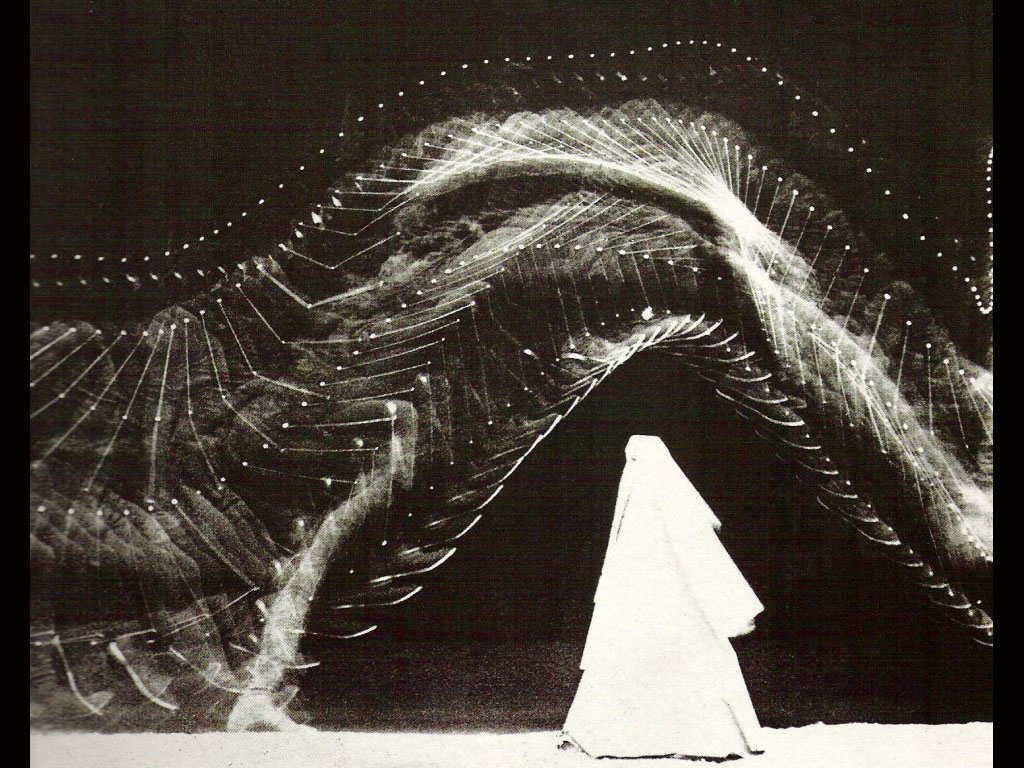
Robin Kelsey’s account of “historical action
photography” is the visual practice most extensively reliant on accidents,
luck, or chance. Indeed, this is the point as Kelsey’s argument holds that
neither modernist nor postmodern views of photography have been willing to
allot any space to chance: “Chance is the ontological vacuum and historical
orphan around which the more favored subjects (institutional, discursive,
individual) of writing on photography have for decades swirled.” (Kelsey, 60)
The modernist point of view is basically a straw man in this narrative.
Examining the case of the famous image of Marines raising the American flag on
Iwo Jima, Kelsey stresses how—contrary to the “thin-slicing” of perceptual data
by which the modernist photographer a la Henri Cartier-Bresson was able to
intentionally grasp a crucial historical moment in a decisive photograph
(Kelsey, 70-1)—photographer Joe Rosenthal not only restaged his shot (the
flag-raising he shot was actually to replace another, smaller flag), but he actually
imagined that another photo in his batch had won such acclaim. (Kelsey, 63;
65-6) Even if we shift the credit from photographer to editor in locating
intentionality, the whole business begins to look pretty fishy: “When a
photographer wheels around and with a click takes a picture that he or she has
never envisioned, and then sense the film off for processing, editorial
selection, and cropping, the relationship between the resulting photograph is
more arbitrary and parasitic [than, say, with Jeff Wall or Walker Evans].”
(Kelsey, 68) While he is willing to allow that great photographers higher
probability of producing good shots than amateurs who just get lucky, Kelsey
contends that this probabilism “does nothing to ease doubts about the meaning
of any individual image.” (Kelsey, 74) And, by Kelsey’s reckoning it is this
kind of fine-grained explication of images in institutional and discursive
terms that has simultaneously marginalized chance from postmodern photography
discourse: “The moderns have downplayed chance because it threatens the heroic
intentionality and momentary revelation of the action photograph. The
postmoderns have downplayed it to emphasize the institutions and discourses
that manage all contingencies of meaning with scrupulous efficiency.” (Kelsey,
76) Although I am not sure that this account is being fair to either camp, the argument is that chance
needs to be seen as a central, pervasive force when dealing with photography:
“The camera, as an automatic picture machine, substituted the action of light
for human labor, opening up new possibilities for chance.” (Kelsey, 75)
Second most chance-based by my reading is James
Nothcote’s vision of Reynolds’s painting technique. Opening with a discussion
of Nathaniel Hone’s The Conjuror of 1775,
Northcote goes on to note how, despite Reynolds’s roles as President of the
Royal Academy and the leading portraitist of his generation, he claimed that “there
was not a man then on earth who had the least notion of colouring.” (Northcote,
17) To remedy the ignorance of the age, Reynolds was in possession of a theory.
Northcote tells us: “It was Sir Joshua’s opinion, that if the vegetable colours
(which are infinitely the most beautiful) were enclosed by varnish from the
external atmosphere, they would not fade.” (Northcote, 20) However, not only
was Reynolds wrong in point of fact as his notoriously fugitive paintings show
(p. 18-19), but he became the docile subject of his advisors and his business.
Northcote puts it this way: “In his own practice, … he would venture on
whatever experiment was recommended to him by any advisor that came his way;
and when he was at any time accused of having spoiled his portraits, by trying
experiments upon them, he answered that it was always his wish to have made these
experiments on his fancy pictures … but that he was prevented from practising
thus, by his being at the time perpetually employed in painting portraits; and
therefore obliged to make his trials on those, as eagerness in the pursuit of
excellence was, in him, uncontrollable.” (Northcote, 21) So, despite his
training and knowledge, Reynolds was unable to control his pigments or himself—deficiencies
made particularly dangerous by the dubious adulterations practiced in London’s
commodified color trade. (Northcote, 22) Also intriguing is the fact that
Northcote closes out his account with an array of “accident” stories (p.
24-28)—of the fallings and befallings in the studio, including one tale in
which Reynolds instructs him to achieve the best posture for depicting drapery
not by elaborate posing, but “by taking the chance of another toss of the
drapery stuff, and by that means I should get nature, which is always superior
to art.” (Northcote, 28)
Chance and accident figure significantly in
Reynolds’s reading Gainsborough. Not only did Gainsborough not enjoy the
stabilizing, ennobling guidance of a trip to Italy, but his manner of working
was significantly beholden to what he happened to come across in his daily
life: “He had a habit of continually remarking to those who happened to be
about him, whatever peculiarity of countenance, whatever accidental combination
of figures, or happy effects of light and shadow, occurred in prospects, in the
sky, in walking the streets, or in company. If, in his walks, he found a
character that he liked, … he ordered him to his house: and from the fields he
brought into his painting-room, stumps of trees, weeds, and animals of various
kinds; and designed them, not from memory, but immediately from the objects. He
even framed a kind of model of landskips, on his table, composed of broken
stones, dried herbs, and pieces of looking glass, which he magnified and
improved into rocks, trees, and water.” (Reynolds, 250) Not only is the artist
beholden to what nature happens to throw before him, but those accidental
specimens were treated by Gainsborough outside of classicizing imitation; they
were merely copied. Yet, like Cozens’s attitude toward the blots—and perhaps
even as with Duchamp’s view to his readymades in De Duve’s reading—Gainsborough’s
“models thus accidentally found” were treated with their own kind of judgment
and choosing informed by an extensive knowledge of the Dutch/Flemish schools.
(Reynolds, 253) Thus, what appears to be accident and chance in Gainsorough’s
finished paintings is judiciously seen as altogether different: “All those odd
scratches [end 257] and marks, which, on a close examination, are so observable
in Gainsborough’s pictures, and even to experienced painters appear rather the
effect of accident than design; this chaos, this uncouth and shapeless
appearance, by a kind of magick, at a certain distance assumes form, and all
the parts seem to drop into their proper places; so that we can hardly refuse
acknowledging the full effect of diligence, under the appearance of chance and
hasty negligence.” (Reynolds, 258) So, although it does indeed have
skill/artistic order within it, Gainsborough’s products—like his
process—appears to be swamped by chance.
Since it uses accident and chance to achieve
“dry”, rational results, I would put Alexander Cozens’s method slightly more to
the skill end of the spectrum than Reynolds’s Gainsborough. The technique came
to him, Cozens tells us, while working with a gifted pupil whose drawing he
wanted to give more vigor: “At this instance happening to have a piece of
soiled paper under my hand, and casting my eyes on it slightly, I sketched
something like a landscape on it, with a pencil in order to catch some hint
which might be improved into a rule. The stains, though extremely faint,
appeared upon revisal to have influenced me, insensibly, in expressing the
general appearance of a landscape.” (Cozens, 167-8) So, depiction of nature
gives rise to an artistic idea that is, in turn, influenced by the inferior
materials that happen to be to hand, which inspires the method. And that method
is to begin with rough forms called “blots” (“an artificial blot is a
production of chance, with a small degree of design” [Cozens, 169]), that are
made to suggest landscapes; then, unctuous, transparent paper is set over the
initial blot-page and a drawing is made by choosing key features in a project
of graphic rationalization. That is, “the spirit of the blot as much as
possible, by taking care not to add anything that is not suggested by it, and
to leave out whatever appears to be unnatural.” (Cozens, 181) So, the artist
had a key role in filtering and processing the chance-like forms; but, they
also exert their capacity for suggestion back though the finished drawing.
By de Voogd’s reading, the marbleized paper
printed in Sterne’s Tristram Shandy
acts as “emblem” of the novel. That is, like the blotchy, stained paper
produced from “a specially prepared liquid ground, [on which] blobs of paint
were dropped, allowed to expand, and then drawn into a pattern by means of a
comb” (de Voogd, 284), the novel appears to be artless, chaotic and ridden with
accidents. This is just a clever ruse: “That novel, like the marbled page, is
seemingly haphazard, the child of contingency, accidental, utterly dependent on
the whims of chance and circumstance. Seemingly, because the expert marble can,
and will, to a very great extent determine beforehand the outcomes of his
design. Similarly, Sterne’s amazing novel is, appearances notwithstanding, tightly
constructed.” (de Voogd, 285) So, there are some contingencies—exactly what
form the marbling would take was left with the artisan, how the marbling would
be affixed into the book was left to the bookbinder, and how the novel was read
relied on the reader; but, overall, this is a feint of chance covering
ingenious authorial skill.
Reynolds’s Discourse
VI is extremely interesting as a meditation on relations between chance and
skill. On the hand, the text opens as a direct rebuke to theories of genius, to
those who would make art inexplicable and thus ultimately reliant upon some
lucky gift from the gods. Reynolds, the hard-working painter and intellectual,
has no time for this talk: “It is very natural for those who are unacquainted
with the cause of any thing
extraordinary, to be astonished at the effect,
and to consider it as a kind of magick.” (Reynolds, 94) Consequently, it
follows for Reynolds that, if they can’t be understood by the common herd,
there are indeed rules for genius and, ultimately, that art is a knowable
matter of science, of causes and effects—not of random, geistlich contingencies: “It cannot be by chance, that excellencies
are produced with any constancy or any certainty, for this is not the nature of
chance; but the rule by which men of extraordinary parts … work.” (Reynolds,
97-8) Now, if this all sounds very skill-oriented, lots of interesting
liquid-talk begins to enter the conversation here with very curious
consequences. First, Reynolds tells us that “Nature is, and must be the
fountain which alone is inexhaustible; and from which all excellencies must
originally flow.” (Reynolds, 101) Further, the path of true art is not obvious;
its principles “do not swim on the superficies.” (Reynolds, 101) So, an
eclectic path, drawing from a range of schools and artistic traditions is the
best way forward. While navigating these water-ways of the modern schools, the
artist should always “trace back art to its fountain-head; to that source from
whence they drew their principal excellencies, the monuments of pure
antiquity.” (Reynolds, 106) And, here is where we get the fabulous paradox
about the roles of accident in the forming of artistic invention from imitation
of past masters. On the one hand, the artist performs some (Duchampian?)
choosing, alchemically converting dross into art: “He will pick up from
dunghills what by a nice chymistry, passing through his own mind, shall be
converted into pure gold.” (Reynolds, 107) Art-making is intentional choosing
and skillful, alchemical transformation. Yet, to conceptualize how it is that
new inventions can be made from old works, Reynolds’s appeals to a liquidy,
alchemical accident in the forming of Corinthian bronze at the burning of
Corinth—a chance event that no one intended. So, as much as this essay is
aiming to rescue art as cause and effect from talk of luck and genius, that business
is nonetheless tucked into the alchemical trope he deploys in this crucial
passage.
To my reading, the de Marchi/Van Miegroet
article was the most committed to a vision of artistic practice organized
around skill—even if it does so while flirting with risk, accident and
contingency. The story that the authors tell is, in a certain sense, a
performance of their argument as they link together two agents, Joshua Reynolds
and Adam Smith, who have lots of superficial, historicist connections in Enlightenment
Britain, but seemingly little in common beyond that. Sharing a similar
conceptions of market conditions and the circumstances that could drive prices,
what ultimately bound Reynolds and Smith together was a conception of ingenuity
or “intuiting ways to link causes and effects that seem remote from one
another. The appearance of remoteness means that there are no obvious
connections. The ingenious inventor, then, is one who forges those connections
via many small links whose eventual chainlike character strikes the outside
observer as ‘strange and wonderful’—precisely because it is more or less
unexpected.” (de Marchi/Van Miegroet, 383) So, as with Gainsborough’s optical
“magick” by which Reynolds himself is taken in, the pleasure of the ingenuity
is in inverse proportion between means and ends—of the distance between
parsimonious means and spectacular ends. (385) And setting out Smith’s theory
of pricing—whereby manipulation of supply, vanity/fancy of consumers and
market-share drive up prices, while also allowing the maker to cut
labor-time—the authors argue that Reynolds’s unstable, experimental pictures
were highly rational enterprises. (393-398) Far from being detrimental to his
business, building some calculated obsolescence into the works was a shrewd
calculation: “Even if only 10 or 20 percent of Reynolds’s pictures cracked
badly, lost paint, or faded, … would be buyers were necessarily entering into a
wager when purchasing a picture from him.” (401) What appears to be chance or
accident in Reynolds’s facture thus needs to be seen as resolution born from a
cold, rational examination of the conditions of artistic production and the
formulation of a practice best calculated to succeed in that environment.
 While filmic techniques allow Bennett to visual aspects of the intercalated disc in motion, she also works with colleagues to render the disc's structural features using architectural modeling software like AutoCAD. As at right, we see a schematized simulation of the disc’s three dimensional structure. Electron tomography visualization of microscopic cell contractions in the heart thus lead to an architectural modeling of the parameters of a feature of special
interest, the intercalated disc. So, if visualization begets architectural modeling, Bennett and
her colleagues also return to the lab where they treat the diseased hearts of mice
as surrogates for—model organisms of—pathological human hearts.
While filmic techniques allow Bennett to visual aspects of the intercalated disc in motion, she also works with colleagues to render the disc's structural features using architectural modeling software like AutoCAD. As at right, we see a schematized simulation of the disc’s three dimensional structure. Electron tomography visualization of microscopic cell contractions in the heart thus lead to an architectural modeling of the parameters of a feature of special
interest, the intercalated disc. So, if visualization begets architectural modeling, Bennett and
her colleagues also return to the lab where they treat the diseased hearts of mice
as surrogates for—model organisms of—pathological human hearts.


























